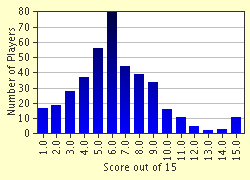Quiz Answer Key and Fun Facts
1. Maps made specifically for orienteering are at a 'human' scale. Terrain and features are mapped to show what a human would readily see when moving through an area, such as boulders that are waist high. What is the preferred scale for orienteering maps?
2. Orienteering maps are standard throughout the world. They are generally printed in five colors, each color representing a different class of features. Of the following, which color does NOT go with its correct feature class?
3. Is 'true' north, or 'magnetic' north indicated on orienteering maps?
4. What is the contour interval (to show the shape of the land) on orienteering maps?
5. Most standard orienteering courses consist of three parts. The 'start', the 'finish', and the in-between places that are circled and numbered on the map. These places are navigated to in sequential order. They are called ______.
6. Orienteering courses are designated by 'color' for the degree of difficulty in getting from start to finish. The easiest course is usually two to three kilometers long. The places to be found along the way are in simple areas, such as along streams or trails. The 'color' for this course is _____.
7. Children generally begin on a course that is marked by a continuous ribbon, or yarn, that leads them through the course so they don't get lost! They get exercise and exposure to maps. This course is known as the _____course.
8. On the orienteering course map, the places to be found are in circles. The 'finish' is in a double circle. What symbol is used for 'start'?
9. At orienteering events, given out along with the course map, is a sheet of paper describing the exact location of the features the orienteer is looking for, such as a boulder, a small hill, or the SW corner of the evergreens. This sheet of paper is known as the ____ sheet.
10. What is located on the ground, which corresponds to the circled locations on the course map, so the orienteer knows the correct spot has been found?
11. To prove that the map's circled location has been found and visited, the orienteer must do something. What does the orienteer do?
12. Where did the sport of orienteering originate?
13. What is a portion of an orienteering course between two consecutive 'checkpoints' called?
14. Folding the map into a small, easily held piece and keeping your thumb on the map near where you are, as you go along the orienteering course, is a good navigational practice. This is known as ______.
15. The sport of long distance cross-country navigation in which teams of two to five members visit as many checkpoints as possible in twenty-four hours is known as _____.
Source: Author
catnippin
This quiz was reviewed by FunTrivia editor
gtho4 before going online.
Any errors found in FunTrivia content are routinely corrected through our feedback system.

